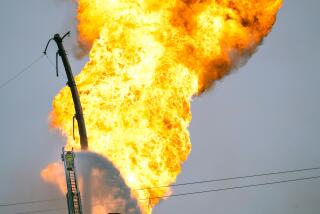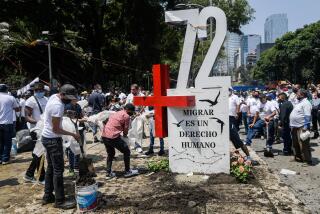Guadalajara Gas Blasts Kill 162 : Mexico: A daylong series of explosions thunders under the city, leveling houses and ripping open streets. More than 800 are injured. The cause is disputed.
GUADALAJARA, Mexico â A chain of underground gas explosions ripped a trail of chaos through this cityâs downtown Wednesday, demolishing dozens of blocks of houses and leaving at least 162 people dead and more than 800 injured.
The explosions, which began in the morning and continued into the night, tore through a mile-and-a-half stretch, blowing automobiles onto rooftops and breaking apart paved streets, which became sunken rivers of mud littered with overturned cars and trucks. Houses were reduced to twisted metal and piles of broken concrete.
The federal government sent in the army to keep order. Hundreds of rescue workers, many wearing masks against lingering gas fumes, climbed over fallen walls and huge chunks of rubble searching for victims.
Guillermo Cosio Vidaurri, governor of Jalisco state, which includes Guadalajara, ordered temporary housing provided for the homeless at the state university and two sports stadiums. Makeshift morgues were set up in gymnasiums and hospitals. The federal government sent in dogs trained to find people trapped in rubble.
Jalisco State Atty. Gen. Leo Bardo Larios Guzman said late Wednesday that the disaster left 162 people dead, 867 wounded and hundreds homeless. However, the Associated Press reported that journalists said they counted 184 bodies before they were forced out of the area by police.
There were conflicting reports as to the source of the gas. Pemex, Mexicoâs state oil monopoly, said the explosions were caused by highly volatile liquid hexane that leaked from a private cooking-oil factory into the sewage system. The hexane is used by the La Central cooking oil company to extract edible oil from seeds, Pemex said.
But the manager of the firm, Jose Morales, told the Associated Press late Wednesday that the firmâs drainage system is not connected to that of the city. âWe will not be a scapegoatâ for this, Morales said, adding that he welcomes an investigation.
The cityâs fire chief said the explosions were caused by gasoline, but Pemex said it has no pipelines in the area.
Atty. Gen. Larios Guzman said the cause of the disaster was yet to be determined. Investigators, he said, were âtesting the contents of the liquidâ still spewing out of the ground.
Both Larios Guzman and Guillermo Vallarta, former mayor of Guadalajara, said the city has a single drainage system into which flows sewage, rainwater and industrial waste.
Guadalajara, Mexicoâs second-largest city, with 3 million people, has a large community of U.S. retirees.
The Red Cross reported at least 1,000 buildings damaged and sent out an appeal for blood and blood plasma. Red Cross spokesman Alejandro Olguin Gonzalez said he expects that more bodies will be found.
âThere is still a lot of rubble that hasnât been moved,â Olguin said over the din of sirens and tractors that were knocking down remnants of walls and power poles.
Police were deployed throughout the area, Larios Guzman said, and 13 people had been arrested for looting.
Gonzalez Cervantes was at home watching television when the first blasts occurred around 10:30 a.m.
âThere was a huge boom. I came outside, and there were cars on roofs and clouds of dust everywhere,â Cervantes said. âPeople were crying. They were hysterical. Iâve never seen anything like it.â
At a government sports complex, bodies of some of the victims were laid out on a basketball court under white tarpaulins. Many were older women, children and babies.
Outside was a line of family members waiting to be allowed in to identify relatives. At the same time, a steady procession of caskets arrived. Some of the people wailed, hugging each other.
Norma Garcia, 24, came to recover her sisterâs body. âMy sister was on her way to the store when the street exploded,â she said. âWe had been smelling gas for two days. They had blocked off the street. Cars couldnât get through. But nobody told us to evacuate.â
After the explosion, she ran up to the roof of her house. âI screamed, âMy sister is down there!â People began digging through the rubble. They said, âThere are two bodies here.â One was my sister.â
Cecilia Mendoza, 35, came to identify her husband. âWe were eating tacos, and the street blew up and came down on top of my husband,â she said. âI managed to get out, and so did my son.â
The 12-year-old boy cried, âMama, Iâm over here,â and she dug him out. But her husband lay crushed to death under tons of asphalt.
Fruit stand owner Salvador Aguila Lopez, 23, told the Associated Press that he had just come from the market and was unloading a truck in front of his house. He heard a rumble, grabbed his boy and threw him into the house, he said.
Before he blacked out, Aguila Lopez said, âthe street rose up and cars flew up. Then when it all settled, one car that was across the street was on top of a mound of rubble that was a house on the other side.â
Aguila Lopez said there had been a baby inside the car. The car landed on the mound of rubble and the baby on the roof of another house near it. The baby was alive, he said.
âIt must have been a miracle,â he said.
The mother of the baby was found in the beauty shop across the street, half-buried by rubble, said Luis Alberto Ruvalcaba, a neighbor. She was alive, too, Ruvalcaba said, âprobably with broken legs.â
Shouting over wailing sirens, rescue helicopters and generators pumping ditch water, Jose Luis Macias, a city water engineer, said the city had received reports of gas leaks Tuesday afternoon.
Around him on hard-hit Gante Avenue, in the center of the damaged area, were half-crumbled buildings and second-story doors dangling over missing rooms. In one damaged building, pictures hung on a free-standing wall that once was part of a bedroom.
Several miles surrounding the explosion site were evacuated as residents there were left without electricity, water or telephone services. Police and army patrols barricaded all major arteries leading into the area, backing up traffic for miles.
Sewer caps were opened throughout the city, allowing the gas to escape and filling the streets with the odor.
The power of the explosions--at least 15, by one count--pulled up entire blocks of asphalt, leaving 15-foot trenches and open rivers of sewage. Trees were uprooted; shoes and clothing were strewn about collapsed houses.
Frantic residents arrived home to look for family members, joining scores of civilians clad in masks digging away rubble. Nurses and doctors waited near ambulances to aid the injured.
Alberto Pulido, 28, was driving a blue Dodge down Violeta Street when he heard a huge blast and the street opened up around him.
âI was saved by the grace of God,â Pulido said, pointing to the wreckage of a semitrailer truck that overturned on his Dodge. âI thought a car had hit me from behind, and then I saw the earth was opening up and my car was sinking. I prayed to God. I thought I was going to die.â
One resident, Maria Rojas, 42, said she had been smelling gas for three days but had heard no news of any serious trouble.
Maria Elena Gizel said her three sisters lived in the area of destruction and she had not been able to find them.
âWhere do we go? We donât know what to do,â she said, panic in her voice.
Local radio announcements urged residents to refrain from using telephones or water and called for help for the homeless. Local hospitals assembled lists of the victims, taping names to their walls.
In Los Angeles, Mexican Consul General Jose Pescador spoke by telephone with Gov. Vidaurri of Jalisco state about three hours after the explosions began.
Vidaurri described the location as in the southeastern part of the city known as Sector Reforma. The center of the disaster, he said, was near Calzada Independencia and Calzada Gonzalez Gallo in a poor and middle-class residential neighborhood.
Telephone lines into Guadalajara were jammed throughout the day Thursday, virtually knocking out communications to the area, said AT&T; spokeswoman Holly Echols. Phone company officials were investigating the extent of equipment damage and urged concerned Californians to refrain from using phone lines and to wait to hear from loved ones.
Hundreds of residents in Los Angeles--home to an estimated 400,000 people with roots in Jalisco--called the local consul seeking information.
Pescador said consular officials were trying to make contact with ham radio operators in Mexico for more information and also trying to obtain the names of the dead.
Times staff writer Stephanie Chavez in Los Angeles contributed to this article.
BACKGROUND
Hexane is a colorless liquid with a faint odor, is sometimes called hexyl hydride and is used, among other things, to extract edible oils from seeds. It is an additive permitted in food for human consumption. But if it is exposed to heat or fire, it is considered a hazard, according to the fifth edition of âDangerous Properties of Industrial Materials.â It is explosive at concentrations as low as 1.2%. Its flash point, or the lowest temperature at which it will ignite with a flash, is minus-7 degrees Fahrenheit. Hexane caused a chain of explosions in Louisville, Ky., 11 years ago; no one was killed.
Site of Blasts
Explosions beginning at about 9:30 a.m. PDT knocked down buildings over several blocks in this central Guadalajara district.
Guadalajaraâs population: 3 million (Mexicoâs second-largest city).
Location: 290 miles northwest of Mexico City, in a rich farming and mining region.
U.S. connection: Some 400,000 people from Jalisco state, of which Guadalajara is the capital, live in the Los Angeles area.
More to Read
Sign up for Essential California
The most important California stories and recommendations in your inbox every morning.
You may occasionally receive promotional content from the Los Angeles Times.










